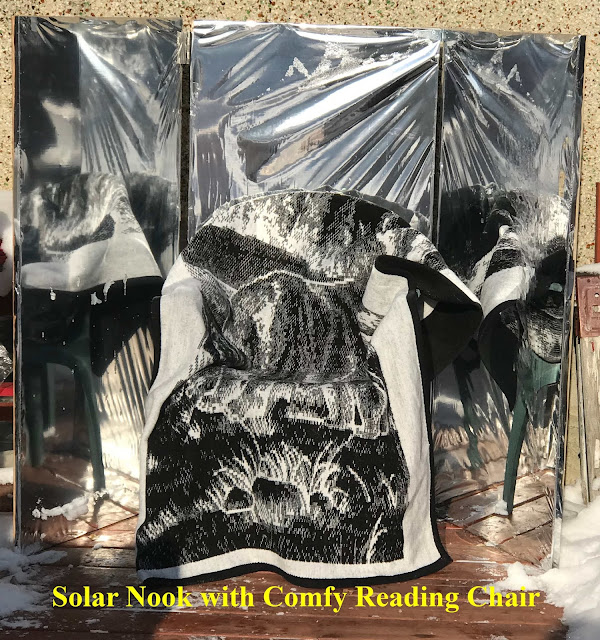Constructing a Pleasant Little Solar-Heated Outdoor Reading Nook
With Covid-19 lockdowns and the possibility that vitimin D is helpful in preventing the condition, I decided to build a nice little solar-heated outdoor reading nook. My deck faces south, so at noon there is a good deal of mid-winter sunshine, even at the high latitude where I live (about 54 degrees north).
It was pretty easy to build, even for someone who isn’t much of a carpenter:
- I bought some light panel boards. I bought 3 panels, 2 feet by 4 feet, thickness of about a quarter inch.
- Since they are kind of flimsy, I reinforced them along the edges, with 1 by 2 studs, using ¾ inch number 8 wood screws. I used these size screws throughout the project.
- Then, to add some extra strength at the corners, I added metal L-shaped brackets for bracing.
- I wrapped one side of the panels (the one without the 1 by 2 showing) with mylar, using packing tape to fix the mylar to the panels.
- To make a 3 piece unit that could be folded up (kind of like a triptych with the sun as my artwork), I put hinges in. I had to be careful to use different sizes of hinges to ensure that the unit could fold up nicely.
- Note
also that you have to have the mylar surfaces arranged in such a way that they
all reflect the sunlight centrally, once the unit is unfolded.
I set the unit up with the mylar surface facing the sun at around local noon (solar time). The left and right panels were put at about a 45 degree angle to the center panel, with the mylar surfaces facing the sun. The unit stood up by itself nicely, though in an unsheltered spot the wind would probably be a problem. One could add a bottom platform (a sort of stand) to take care of this.
On a day that was about at the freezing point, the area where I placed my chair was about 10 degrees Celius or 15 degrees Farenheit warmer than the ambient air. While wearing a padded vest over my shirt, I could even roll up my shirt sleeves and dispense with headwear and gloves.
This also provides plenty of sunlight for reading, which is handy when using a kindle. If you are using your phone or ipad, there can be some glare, though it is managable if you orient the screen the right way. I found that I could comfortably sit and read for at least a couple of hours, especially after high noon. Plus, I got a fair bit of sunshine and fresh air, which is good for the spirit.
Once I was done reading, I folded up the unit and stored it against the wall of the house, putting a home-made planter in front of it (weighted down with a few bricks), so that it wouldn’t fall or be blown down in the wind.
One warning – after finishing the project you can almost guarantee a spell of cloudy weather. :)
Come spring, I plan to use this unit to jump-start our bedding plants. In the summer, it would likely be too hot to use for much, except maybe keeping a coffee pot warm. I will have to try that.
=====================================================
And, here’s a pleasant little travel story about a place where a solar-heated reading nook could be quite useful. You would definitely have to be careful about your unit being knocked over by the wind, though.
A Drive Across Newfoundland
U.S.: https://www.amazon.com/dp/B07NMR9WM8
U.K.: https://www.amazon.co.uk/dp/B07NMR9WM8
Germany: https://www.amazon.de/dp/B07NMR9WM8
Japan: https://www.amazon.co.jp/dp/B07NMR9WM8
Canada: https://www.amazon.ca/dp/B07NMR9WM8
Australia: https://www.amazon.com.au/dp/B07NMR9WM8
India: https://www.amazon.in/dp/B07NMR9WM8
Newfoundland, Canada’s most easterly province, is a region that is both fascinating in its unique culture and amazing in its vistas of stark beauty. The weather is often wild, with coastal regions known for steep cliffs and crashing waves (though tranquil beaches exist too). The inland areas are primarily Precambrian shield, dominated by forests, rivers, rock formations, and abundant wildlife. The province also features some of the Earth’s most remarkable geology, notably The Tablelands, where the mantle rocks of the Earth’s interior have been exposed at the surface, permitting one to explore an almost alien landscape, an opportunity available on only a few scattered regions of the planet.
The city of St. John’s is one of Canada’s most unique urban
areas, with a population that maintains many old traditions and cultural
aspects of the British Isles. That’s true of the rest of the province, as well,
where the people are friendly and inclined to chat amiably with visitors. Plus,
they talk with amusing accents and party hard, so what’s not to like?
This account focusses on a two-week road trip in October 2007, from St. John’s
in the southeast, to L’Anse aux Meadows in the far northwest, the only known
Viking settlement in North America. It also features a day hike visit to The
Tablelands, a remarkable and majestic geological feature. Even those who don’t
normally consider themselves very interested in geology will find themselves
awe-struck by these other-worldly landscapes.









No comments:
Post a Comment